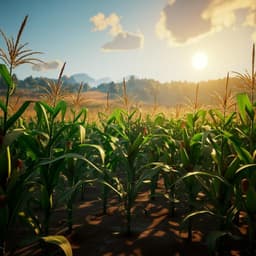
Agriculture
Swiss agriculture can become more sustainable and self-sufficient by shifting from forage to grain legume production
B. Keller, C. Oppliger, et al.
In Switzerland, the pursuit of sustainable livestock production faces significant environmental challenges due to heavy reliance on feed imports. Research by Beat Keller, Corina Oppliger, Mirjam Chassot, Jeanine Ammann, Andreas Hund, and Achim Walter highlights the promising potential of local grain legume cultivation, such as pea, soybean, and faba bean, to enhance self-sufficiency and improve ecological health while addressing animal protein consumption.
~3 min • Beginner • English
Introduction
The study addresses how Switzerland can reduce the environmental impacts of its agriculture—dominated by livestock-related greenhouse gas emissions and high external costs—by shifting toward plant-based protein production from grain legumes. Legumes can substantially lower GHG emissions compared to animal products and contribute agronomic benefits via biological nitrogen fixation, reduced fertilizer needs, and potential carbon sequestration. Despite nutritional advantages and growing market demand for plant-based products, grain legumes occupy only a small share of arable land in Switzerland, and protein feed imports (especially soybean) remain high. The research aims to (i) assess the potential of Swiss agricultural land for legume cultivation using climate (growing degree days), altitude, soil and terrain constraints, and (ii) analyze Switzerland’s protein self-sufficiency under scenarios of expanded legume production coupled with reduced livestock and minimized feed imports. The work combines a qualitative expert assessment across the value chain with a quantitative spatial and systems analysis.
Literature Review
The paper synthesizes literature showing that legume-based proteins can provide major environmental benefits versus animal-based proteins, including substantially lower GHG emissions for meat analogues and agronomic advantages from nitrogen fixation and pre-crop effects. Prior studies indicate European dependence on imported soybean and the potential to increase self-sufficiency by expanding grain legume cultivation. Species-specific knowledge highlights pea, faba bean, and soybean as promising in Switzerland, with cautions regarding antinutritional factors and disease/pest sensitivities. Policy experiences in Europe to stimulate legume production have had limited success, whereas integrated national approaches in Canada and Australia combining supply chain organization, policy support, breeding, and agronomy achieved better outcomes. Consumer acceptance of alternative proteins is rising but still limited. Background also notes health and nutritional aspects of legumes and the evolving Swiss market for meat analogues.
Methodology
The study used a mixed-methods approach.
Qualitative analysis: Interviews with 15 Swiss experts (advisors, breeders, researchers, processors, farmers) followed by a 17-question survey of 29 experts captured perceived challenges, opportunities, and measures to increase grain legume production for human consumption. Interviews (30–60 min) were recorded, anonymized, transcribed, and coded; survey responses were collected online. Ethical approval: ETH Ethics Committee EK 2021-N-196.
Quantitative spatial assessment of production potential: Suitable land for soybean, summer faba bean, and summer pea was identified using (i) land and soil suitability and slope (<25%) from the Swiss digital soil map (very good to moderate production potential), (ii) growing degree days (GDD) thresholds derived from literature (soybean 1500°Cd base 6°C; faba bean 1600°Cd base 4°C; pea 1300°Cd base 4.4°C) computed from MeteoSwiss 1×1 km gridded daily temperature (2016–2020), and (iii) altitude constraints adjusted upward by 100 m versus literature based on observed warming (max altitudes: soybean ~600 m, faba bean ~700–800 m, pea ~1200–1300 m, depending on crop and season). GIS processing in QGIS (3.20) and R (4.1.3) rasterized data at 10×10 m resolution and extracted per-pixel suitability.
Scenarios and crop rotation: Two scenarios were analyzed. Scenario I (moderate): only current arable land and temporary grassland; Scenario II (maximal): adds suitable permanent grassland (slope <25%) convertible to arable use. National rotation constraints imposed cultivation breaks: 3 years for soybean and faba bean; 6 years for pea. Single-legume rotations use up to 25% of potential area; combined rotations allow up to 37.5%, stacking species by altitude niches: below 600 m a.s.l. soybean (25%) and faba bean (12.5%); 600–800 m a.s.l. faba bean (25%) and pea (12.5%); >800 m a.s.l. pea (12.5%).
Yields and protein: Yield ranges for 2016–2020 from FAOSTAT were used to compute protein yields with species-specific protein contents (Swiss feed database). Ten evenly spaced yield levels across min–max defined sensitivity runs. Protein quality adjustments were applied via DIAAS factors (soybean 1.0; faba bean 0.6; pea 0.8 equivalents) when comparing plant to animal protein substitution.
Feed–food balance and self-sufficiency: A system model rebalanced feed and food under expanded legume area. Imports of concentrated feed (soybean oil cake and cereals; total 632,500 t DM in 2020) were minimized/set to zero. Land for temporary grassland and fodder maize was reduced to free area for legumes; in Scenario II selected permanent grassland was converted proportionally. Roughage reductions were computed from area changes and baseline productivity; concentrated feed balances accounted for reduced imports, newly available domestic legume protein diverted to feed (converted to oil-cake DM using a factor of 2 from t protein to t DM), and freed concentrates from reduced ruminant numbers. The model solved for proportions of remaining ruminant (rruminants) and monogastric (rmonogastrics) production relative to baseline, and the allocation of legume protein to food versus feed using equations (1)–(10). Gross and net self-sufficiency were computed by dividing domestic food energy production (gross allowing feed imports; net using only domestic fodder) by consumption energy, with improved scenarios eliminating egg and meat imports and minimizing feed imports.
Sensitivity analysis: Varied legume protein output and roughage production across the 2016–2020 yield ranges (10×10 grid, n=100 runs) to assess sensitivity of rruminants, rmonogastrics, and self-sufficiency outcomes. Baseline production/consumption were from 2020 statistics.
Key Findings
- Qualitative insights: Experts identified key barriers to wider legume adoption: (i) pricing structures and policy framework (tariff protection and past financial disadvantages for food legumes vs feed, recently corrected in 2023), (ii) limited breeding programs and lack of site-adapted varieties and agronomic guidance, (iii) supply-chain gaps (collection points, quality specifications), and (iv) agronomic risks (yield instability, biotic stress). Greatest cultivation potential was perceived for pea and soybean; faba bean also promising.
- Baseline (2020) context: Arable land 397,896 ha; permanent grassland 600,686 ha; temporary grassland 125,393 ha; fodder maize 46,847 ha. Legume areas: soybean 2042 ha, faba bean 957 ha, dry pea 3573 ha. Animal protein consumption totaled 204,184 t (including net imports); domestic production was 128,478 t ruminant and 63,836 t monogastric protein. Concentrated feed use was 1,523,395 t DM (about 54% imported); roughage about 5.88 Mt DM.
- Scenario I (arable land only): Potential single-crop suitable areas: soybean 206,422 ha, faba bean 282,625 ha, pea 294,875 ha. With rotation breaks, production areas would be 51,605 ha (soybean), 70,656 ha (faba bean), 42,125 ha (pea). Corresponding protein production (t): soybean 55,230 (±8607), faba bean 54,099 (±8021), pea 25,109 (±4877). A combined rotation across altitudinal niches on 107,734 ha could produce 96,293 (±15,004) t legume protein, sufficient to replace about 84 (±13)% of meat protein consumption.
- Scenario II (including suitable permanent grassland): Potential single-crop suitable areas: soybean 319,359 ha, faba bean 460,826 ha, pea 510,795 ha. With rotation breaks, production areas become 79,840 ha (soybean), 115,206 ha (faba bean), 72,971 ha (pea). Combined rotation on 181,479 ha could produce up to 159,525 (±24,992) t legume protein (text) and, per tabulated totals, up to 217,231 (±22,843) t (single-crop sum), corresponding to roughly 139–192 (±22)% of Swiss meat protein consumption, depending on combination/assumptions.
- Improved self-sufficiency with minimized imports and maximized legumes (Scenario II land reallocation): Requires reducing temporary grassland (−70%; −87,775 ha) and fodder maize (−70%; −32,793 ha) and converting about 8% of permanent grassland (−46,230 ha) to arable, lowering roughage by ~1.83 Mt DM. Model results indicate livestock production scales to rruminants ≈ 0.69 (±0.002) and rmonogastrics ≈ 0.66 (±0.06) of baseline. Gross and net self-sufficiency improve from 55.6% and 49.3% to about 58.9 (±1.2)% and 58.4 (±1.2)%, respectively. Concentrated feed imports (~632,500 t DM) can be eliminated; domestic legume production supplies ~136,869 (±56,952) t DM of new concentrate equivalents. The new diet composition shifts to roughly 37.8–44.0% grain legume protein, 32.2–32.7% milk protein, 21.9–26.9% meat protein, and 1.9–2.6% egg protein. Overall, about 41% of animal protein consumption could be replaced by plant-based protein while still preserving about 32% of milk and 24% of meat protein.
- Ecological implications: Reducing livestock by ~33% while increasing legume area supports national GHG mitigation targets; legumes lower nitrogen fertilizer needs and emissions and may enhance carbon sequestration (especially as cover crops). Converting permanent grassland risks soil carbon losses and erosion and should be minimized and carefully managed; grasslands remain valuable, particularly at higher elevations with forage legumes. Lower soybean imports reduce deforestation and water-use pressures abroad.
Discussion
The findings demonstrate that Swiss agriculture could substantially expand domestic production of soybean, faba bean, and pea by reallocating land from forage (temporary grassland and fodder maize) to grain legumes. This shift can deliver sizeable plant-based protein quantities capable of replacing a significant share of meat-derived protein, and, when coupled with reduced livestock numbers and minimized feed imports, can improve national self-sufficiency. The scenario analysis links spatial suitability (soil, climate, altitude) and rotation constraints to realistic production areas and yields, quantifying trade-offs with roughage supply and animal production. Impacts directly address the research aims: achieving both environmental benefits (lower GHG, nitrogen savings, reduced deforestation pressure) and improved food system resilience. Realization depends on overcoming economic and policy barriers, strengthening breeding and agronomic support to improve yield stability and disease resistance (e.g., mitigating pea root rot “soil fatigue”), and building processing/collection infrastructure. Consumer acceptance trends and integrated policy–supply chain approaches (as seen internationally) will be critical for scaling.
Conclusion
Expert elicitation and quantitative modeling indicate high potential to increase grain legume cultivation in Switzerland, particularly soybean, faba bean, and pea. With coordinated improvements in breeding, agronomy, policy, pricing, and supply-chain organization, Switzerland could reallocate land from forage to legumes, producing plant proteins at levels that meet or exceed current meat protein consumption. Maximizing legume area while reducing livestock would improve food self-sufficiency (gross and net), reduce concentrated feed imports by over 600,000 t DM, and lower environmental impacts. Broader implementation requires cross-sector coordination among policymakers, producers, processors, and consumers, alongside continued research on rotation health, disease resistance, and market organization. Future work should refine spatial yield forecasting (including precipitation and erosion risks), evaluate economic impacts of land-use shifts, and optimize nutrition strategies considering protein quality and micronutrients.
Limitations
The study’s key limitations include: (i) Spatial suitability and yield estimates rely on GDD, soil, and altitude criteria with yields averaged over areas; finer-scale models including additional climatic factors (e.g., precipitation, erosion risk) could adjust production estimates, though sensitivity analyses suggest main conclusions are robust. (ii) Focus on protein only; legume protein quality (DIAAS) varies with preparation and combinations, and other nutrients (fats, micronutrients such as iron, zinc, magnesium, vitamin B12) were not comprehensively assessed. (iii) The crop rotation configuration presented is one of many possible arrangements and depends on feed composition choices (e.g., maize vs grass shares). (iv) Economic impacts of converting grassland to arable land and scaling legume value chains require further study; nonetheless, soybean, faba bean, and pea show competitive remuneration relative to winter wheat under Swiss conditions, and soybean can compete with imports when processing chains exist.
Related Publications
Explore these studies to deepen your understanding of the subject.







